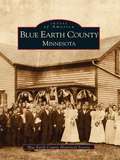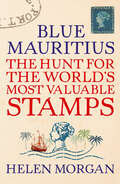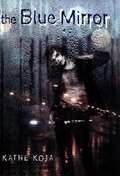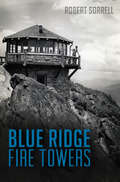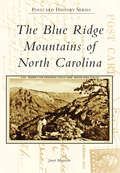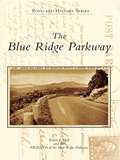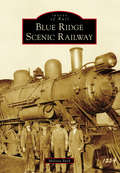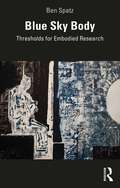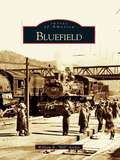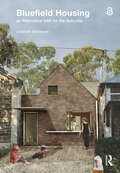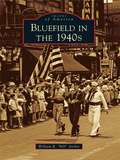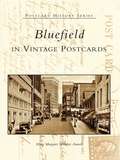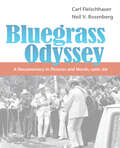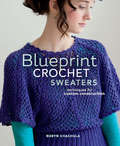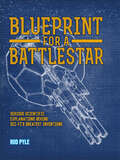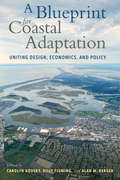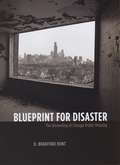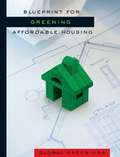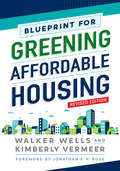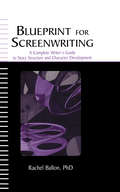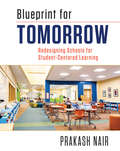- Table View
- List View
Blue Earth County, Minnesota
by Blue Earth County Historical SocietyThe first white settlers came to what is now Blue Earth County in 1852, and discovered an abundance of rich land, streams, rivers, and lakes for survival in southern Minnesota. Showcasing photographs from the area's first 70 years, the Blue Earth County Historical Society has compiled over 200 images of the lifestyles and advancements of its earliest settlers.The pioneers of Blue Earth County recognized the potential for success at the bend in the Minnesota River, and forged a vibrant community out of the big woods and prairies of southern Minnesota. Pictured here are the fruits of those settlers' labors, seen in vintage images from the townships of Blue Earth County, including life on the farms and in the towns.
Blue Mauritius: The Hunt for the World's Most Valuable Stamps
by Helen MorganFollow the adventures of the world's most sought-after postage stamps—from a tropical Indian Ocean island to the hushed atmosphere of the modern auction room—in this dramatic and passionate tale of the first stamp hunters. In September 1847 colored squares of paper were stuck on to envelopes and used to send out admission cards to a fancy-dress ball on the tropical island of Mauritius. No one at the party would have guessed that these stamps would one day be worth more than a million dollars. When a two-pence "Blue Mauritius" surfaced on the fledgling French stamp-collecting market in 1865 it gained instant celebrity. Soldiers, schoolboys, and the entire German nation became obsessed with finding one of these extremely rare examples. When in 1903 a perfect specimen, discovered in a childhood album, was bought at auction by the Prince of Wales, the Blue Mauritius gained superstar status. Even now, "Post Office Mauritius" stamps are synonymous with fame, wealth, and mystery. The most coveted scraps of paper in existence, this is their story—from their birth during days of sail, taking them from Port Louis to Bordeaux, India and Great Britain, Switzerland and Japan, into the hearts and imagination of collectors everywhere.
The Blue Mirror
by Kathe KojaSeventeen-year-old loner Maggy Klass, who frequently seeks refuge from her alcoholic mother's apartment by sitting and drawing in a local cafe, becomes involved in a destructive relationship with a charismatic homeless youth named Cole.
Blue Ridge Fire Towers (Landmarks)
by Robert SorrellFire lookout towers have graced the highest peaks in the Blue Ridge Mountains for more than a century. Early mountaineers and conservationists began constructing lookouts during the late 1800s. By the 1930s, states and the federal government had built thousands of towers around the country, many in the Blue Ridge. While technology allowed forestry services to use other means for early detection of fires, many towers still stand as a testament to their significance. Author Robert Sorrell details the fascinating history of the lookouts in the Blue Ridge's forests.
Blue Ridge Mountains of North Carolina, The (Postcard History Series)
by Janet MorrisonRunning along the western border of the state, the Blue Ridge Mountains of North Carolina have beckoned explorers, settlers, and tourists for generations. Within the ridges and valleys of these mountains, spectacular natural features abound, such as Blowing Rock, Looking Glass Falls, and Linville Gorge. Here, the highest mountain peak in North Carolina, Mount Mitchell, rises to an astonishing 6,684 feet. Recreationally, these mountains boast massive tourist appeal; visitors can hike the Appalachian Trail, drive the Blue Ridge Parkway, or explore the Great Smoky Mountains National Park. This title showcases the natural beauty of the unique mountain range and the numerous mountain communities that many call home.
Blue Ridge Parkway, The
by Karen J. Hall FRIENDS of the Blue Ridge ParkwayIn the late 1890s, the Blue Ridge Parkway was envisioned by many as a great getaway and nature preserve. The concept materialized in the early 20th century, when John D. Rockefeller donated the first $5 million to begin purchasing land for the project. Located at the top of the great Appalachian ridges, the parkway covers 469 winding miles of mountains and meadows lined with lush wildflowers, old farms, and split-rail fences. Inspiring scenery makes for a journey rich in history and mountain culture.
Blue Ridge Scenic Railway
by Melissa BeckHaving whistled its first "all aboard" in 1988, the Blue Ridge Scenic Railway now rambles alongside the Toccoa's clear waters, treating 50,000-plus sightseers annually to verdant mountain scenery. This former Cherokee land's pioneers carved homesteads from rough terrain, doggedly hauling goods via mule wagon. The discovery of rich copper veins in nearby Polk County, Tennessee, attracted an influx of settlers, but before they could enjoy an Industrial Age boom including rail for faster freight movement, they would endure route changes, bankruptcies, and land-rights issues. As Fannin, Polk, and surrounding counties neared the 20th century, the long-anticipated railroad arrived, and with it prosperity. This is a photographic history of the copper miners, shop owners, homesteaders, and railroad workers who made these mountains their homes, often for many proud generations.
Blue Sky Body: Thresholds for Embodied Research
by Ben SpatzBlue Sky Body: Thresholds for Embodied Research is the follow-up to Ben Spatz's 2015 book What a Body Can Do, charting a course through more than twenty years of embodied, artistic, and scholarly research. Emerging from the confluence of theory and practice, this book combines full-length critical essays with a kaleidoscopic selection of fragments from journal entries, performance texts, and other unpublished materials to offer a series of entry points organized by seven keywords: city, song, movement, theater, sex, document, politics. Brimming with thoughtful and sometimes provocative takes on embodiment, technology, decoloniality, the university, and the politics of knowledge, the work shared here models the integration of artistic and embodied research with critical thought, opening new avenues for transformative action and experimentation. Invaluable to scholars and practitioners working through and beyond performance, Blue Sky Body is both an unconventional introduction to embodied research and a methodological intervention at the edges of contemporary theory.
Blue & White Japan
by Yutaka Satoh Amy Slyvester KatohThis delightful book shows that wherever it is used, the creative juxtaposition of blue and white provides both visual nourishment and spiritual balm. From the ephemeral beauty of a wind-blown noren curtain to the powerful geometry of zabuton cushions, to the calming symmetry of a soba cup - whether new or old, homely or sophisticated - all of these objects convey a lyrical message that speaks to our senses, inspiring us to seek out new ways to collect, create, and live with Japanese blue & white
Bluefield
by William R. ArcherThe remarkable story of Bluefield represents a unique combination of geology, geography, and opportunity. Once just the confluence of a handful of family farms in southern West Virginia, Bluefield was put on the map, literally,in the 1880s, when the Norfolk & Western Railway came to town. The company's influence on the rural landscape was overwhelming, and soon, Bluefield was transformed into the center of a coal-fired universe and became a major thoroughfare for the then-thriving mining industry. Though the company--not the coal--was king in Bluefield, enterprising men and women could, and did, share in itssuccess. The city evolved into a successful supply center for the enormous network of towns that sprung up almost overnight throughout the region's coalfields. For the next 60 years, Bluefield experienced dramatic growth, enticing a diverse group of newcomers who helped to build the strong cultural heritage that continues to play a prominent role in the community to the present day.
Bluefield Housing as Alternative Infill for the Suburbs
by Damian MadiganSuburbanised cities share a common dilemma: how to transition to more densely populated and socially connected urban systems while retaining low-rise character, avoiding gentrification, and opening neighbourhoods to more diverse housing choices. Bluefield Housing offers a new land definition and co-located infill model addressing these concerns, through describing and deploying the types of ad-hoc modifications that have been undertaken in the suburbs for decades. Extending green-, brown-, and greyfield definitions, it provides a necessary middle ground between the ‘do nothing’ attitude of suburban preservation and the ‘do everything’ approach of knock-down-rebuild regeneration. An adjunct to ‘missing middle’ and subdivision densification models, with a focus on co-locating homes on small lots, Bluefield Housing presents a unified design approach to suburban infill: retrofitting original houses, retaining and enhancing landscape and urban tree canopies, and delivering additional homes as low-rise additions and backyard homes suited to the increasingly complex make-up of our households. Extensively illustrated by the author with engaging architectural design studies, Damian Madigan describes how existing quirks of suburban housing can prompt new forms of infill, explains why a new suburban densification model is not only necessary but can be made desirable for varied stakeholders, and charts a path towards the types of statutory and market triggers required to make bluefield housing achievable. Using Australian housing as an example but addressing universal concerns around neighbourhood character, demographic needs, housing diversity, dwelling flexibility, and landscape amenity, Bluefield Housing offers innovative suburban infill ideas for policy makers, planners, architects, researchers and students of housing and design studies, and for those with a stake in the future of the suburbs.
Bluefield Housing as Alternative Infill for the Suburbs
by Damian MadiganSuburbanised cities share a common dilemma: how to transition to more densely populated and socially connected urban systems while retaining low-rise character, avoiding gentrification, and opening neighbourhoods to more diverse housing choices. Bluefield Housing offers a new land definition and co-located infill model addressing these concerns, through describing and deploying the types of ad-hoc modifications that have been undertaken in the suburbs for decades. Extending green-, brown-, and greyfield definitions, it provides a necessary middle ground between the ‘do nothing’ attitude of suburban preservation and the ‘do everything’ approach of knock-down-rebuild regeneration.An adjunct to ‘missing middle’ and subdivision densification models, with a focus on co-locating homes on small lots, Bluefield Housing presents a unified design approach to suburban infill: retrofitting original houses, retaining and enhancing landscape and urban tree canopies, and delivering additional homes as low-rise additions and backyard homes suited to the increasingly complex make-up of our households.Extensively illustrated by the author with engaging architectural design studies, Damian Madigan describes how existing quirks of suburban housing can prompt new forms of infill, explains why a new suburban densification model is not only necessary but can be made desirable for varied stakeholders, and charts a path towards the types of statutory and market triggers required to make bluefield housing achievable. Using Australian housing as an example but addressing universal concerns around neighbourhood character, demographic needs, housing diversity, dwelling flexibility, and landscape amenity, Bluefield Housing offers innovative suburban infill ideas for policy makers, planners, architects, researchers and students of housing and design studies, and for those with a stake in the future of the suburbs.The Open Access version of this book, available at www.taylorfrancis.com, has been made available under a Creative Commons Attribution-Non Commercial-No Derivatives (CC-BY-NC-ND) 4.0 license.
Bluefield in the 1940s
by William R. ArcherAlmost every American city enjoys a magical time in history when all the tumblers of fate, luck, hard work, and good fortune seem to fall into place, and the city enjoys a golden era. The 1940s were just such a time in the city of Bluefield. At the dawn of the decade, the United States was on the verge of entering the greatest war the world has ever known, and the coal that flowed through Norfolk and Western Railway's Bluefield yard was destined to fuel an Allied victory. But there is so much more than war and coal at the heart of Bluefield's story. The 1940s were a time of inspiration for men like Nobel laureate John F. Nash Jr., a time of artistic discovery for men like Joseph Dodd of Bluefield State College, a time of valor and heroism for Congressional Medal of Honor recipient S.Sgt. Junior Spurrier, and a period of success in business, arts, and professional fields for hundreds of Bluefield's sons and daughters.
Bluefield in Vintage Postcards
by Mary Margaret AnnettNestled at the foot of East River Mountain in the southern tip of West Virginia, Bluefield calls itself "Nature's Air-Conditioned City" and is a place of great cultural, industrial, and natural wealth. The early to mid-1900s were a booming time for the city, thanks to coal mining and the Norfolk and Western Railway. For the many people who lived in or traveled through the region during that era, postcards provided a simple and convenient way to send both personal correspondence and business communications. Today, Bluefield continues to change and evolve but maintains a strong sense of history, with many of its buildings and homes listed on the National Register of Historic Places.
Bluegrass Odyssey: A Documentary in Pictures and Words, 1966-86 (Music in American Life)
by Neil V RosenbergThe fruit of four decades of collaboration between bluegrass music’s premier photographer and premier historian, Bluegrass Odyssey is a satisfying and visually alluring journey into the heart of a truly American music. Combining more than two hundred of Carl Fleischhauer’s photographs with Neil V. Rosenberg’s expert commentary, this elegant visual documentary captures the music-making with the culture and community that foster it.
Blueprint Crochet: Modern Designs for the Visual Crocheter
by Robyn ChachulaUsing graphic illustrations and clear guidelines, this straightforward crochet resource is essential for the visual crafter - anyone who understands maps better than verbal directions, and images better than basic step-by-step instructions. Covering a wide range of skill levels, it introduces the universal symbol language of crochet to newcomers, while also satisfying the need for intermediate level patterns. Each crochet design is broken down stitch-by-stitch in a diagram format so that visual learners can see, as well as read, each step. With contemporary designs from trendy to classic, each project offers a fresh take on crochet, providing modern patterns for purses, necklaces, belts, dresses, shawls, and more.
Blueprint Crochet Sweaters: Techniques for Custom Construction
by Robyn ChachulaLearn the must-have basics of sweater construction and ways to achieve better-fitting garments! Best-selling author of Blueprint Crochet, Robyn Chachula presents an approachable resource on the basics of crochet design. This friendly introduction to sweater and garment construction will give you a deeper understanding of working with crochet and help you make better-fitting garments in the process. In this collection of 16 patterns, Robyn focuses on four basic garment types and their variations--"classic" construction (including raglan, drop-sleeve, and side-saddle sleeve); unique construction (side-to-side or from the bottom up, around the shoulder, and back down); motif construction; and top-down (both round and raglan types). The perfect introduction to the building blocks of crochet sweater construction, Blueprint Crochet Sweaters breaks down intimidating garment design into easily digestible parts, offering a deeper appreciation and understanding of how to create projects that reflect your own personal style.
Blueprint for a Battlestar: Serious Scientific Explanations Behind Sci-Fi's Greatest Inventions
by Rod Pyle“An enjoyable source of information on a wide variety of real or imagined technological marvels of the space age.” —National Space SocietyThis beautifully illustrated pop science book answers the enduring questions raised by science fiction, such as: Do hoverboards really exist, how can you bring a dinosaur back to life and can we really travel in time and space.Packed with stunning images, including seventy-five illustrations created exclusively for this book, Blueprint for a Battlestar takes twenty-five remarkable and memorable technologies from the world of sci-fi, from Star Wars and The Matrix to Ironman and The Terminator. Each concept will be explained and dissected to reveal the real science behind it. Some are boldly obvious—such as the Death Star and exoskeletons—and some less so (think bio-ports or cloaking devices). All are fascinating and will make wonderful explorations into the science of the future as we understand it today.“This is dream fuel for aspiring STEM students of all sorts. Blueprint for a Battlestar is a gateway drug for brainstorming that could change the world.” —Seattle Book Review“Will take readers on a fact-finding mission where the science is explained and the fiction just may become reality. Can it really work? For the sake of all those young engineers out there dreaming of a future filled with massive battlestars stretching far across the galaxy, we can only hope.” —Amazing Stories Magazine“A fun book that offers serious exploration of some of the technology that could be common place in the not too distant future.” —The Review Graveyard
A Blueprint for Coastal Adaptation: Uniting Design, Economics, and Policy
by Carolyn KouskyTens of millions of Americans are at risk from sea level rise, increased tidal flooding, and intensifying storms. The design and policy decisions that have shaped coastal areas are in desperate need of updates to help communities better adapt to a changing climate. A Blueprint for Coastal Adaptation identifies a bold new research and policy agenda and provides implementable options for coastal communities. In this book, coastal adaptation experts discuss the interrelated challenges facing communities experiencing sea level rise and increasing storm impacts. These issues extend far beyond land use planning into housing policy, financing for public infrastructure, insurance, fostering healthier coastal ecosystems, and more. Deftly addressing far-reaching problems from cleaning up contaminated, abandoned sites, to changes in drinking water composition, chapters give a clear-eyed view of how we might yet chart a course for thriving coastal communities. They offer a range of climate adaptation policies that could protect coastal communities against increasing risk, while preserving the economic value of these locations, their natural environments, and their community and cultural values. Lessons are drawn from coastal communities around the United States to present equitable solutions. The book provides tools for evaluating necessary tradeoffs to think more comprehensively about the future of our coastal communities. Coastal adaptation will not be easy, but planning for it is critical to the survival of many communities. A Blueprint for Coastal Adaptation will inspire innovative and cross-disciplinary thinking about coastal policy at the state and local level while providing actionable, realistic policy and planning options for adaptation professionals and policymakers.
Blueprint for Disaster: The Unraveling of Chicago Public Housing
by D. Bradford HuntNow considered a dysfunctional mess, Chicago's public housing projects once had long waiting lists of would-be residents hoping to leave the slums behind. So what went wrong? To answer this complicated question, D. Bradford Hunt traces public housing's history in Chicago from its New Deal roots through current mayor Richard M. Daley's Plan for Transformation. In the process, he chronicles the Chicago Housing Authority's own transformation from the city's most progressive government agency to its largest slumlord. Challenging explanations that attribute the projects' decline primarily to racial discrimination and real estate interests, Hunt argues that well-intentioned but misguided policy decisions- ranging from design choices to maintenance contracts- also paved the road to failure. Moreover, administrators who fully understood the potential drawbacks did not try to halt such deeply flawed projects as Cabrini-Green and the Robert Taylor Homes. These massive high-rise complexes housed unprecedented numbers of children but relatively few adults, engendering disorder that pushed out the working class and, consequently, the rents needed to maintain the buildings. The resulting combination of fiscal crisis, managerial incompetence, and social unrest plunged the CHA into a quagmire from which it is still struggling to emerge. Blueprint for Disaster, then,is an urgent reminder of the havoc poorly conceived policy can wreak on our most vulnerable citizens.
Blueprint for Greening Affordable Housing
by Global Green UsaBlueprint for Green Affordable Housing is a guide for housing developers, advocates, public agency staff, and the financial community that offers specific guidance on incorporating green building strategies into the design, construction, and operation of affordable housing developments. A completely revised and expanded second edition of the groundbreaking 1999 publication, this new book focuses on topics of specific relevance to affordable housing including: *how green building adds value to affordable housing *the integrated design process *best practices in green design for affordable housing *green operations and maintenance *innovative funding and finance *emerging programs, partnerships, and policies Edited by national green affordable housing expert Walker Wells and featuring a foreword by Matt Petersen, president and chief executive officer of Global Green USA, the book presents 12 case studies of model developments and projects, including rental, home ownership, special needs, senior, self-help, and co-housing from around the United States. Each case study describes the unique green features of the development, discusses how they were successfully incorporated, considers the project's financing and savings associated with the green measures, and outlines lessons learned. Blueprint for Green Affordable Housing is the first book of its kind to present information regarding green building that is specifically tailored to the affordable housing development community.
Blueprint for Greening Affordable Housing, Revised Edition
by Walker Wells Kimberly VermeerBlueprint for Greening Affordable Housing is the most comprehensive resource on how green building principles can be incorporated into affordable housing design, construction, and operation. In this fully revised edition, Walker Wells and Kimberly Vermeer capture the rapid evolution of green building practices and make a compelling case for integrating green building in affordable housing. The Blueprint offers guidance on innovative practices, green building certifications for affordable housing, and the latest financing strategies. The completely new case studies share detailed insights on how the many elements of a green building are incorporated into different housing types and locations. Every affordable housing project can achieve the fundamentals of good green building design. The Blueprint gives project teams what they need to push for excellence.
Blueprint for Screenwriting: A Complete Writer's Guide to Story Structure and Character Development
by Rachel BallonBlueprint for Screenwriting demystifies the writing process by developing a "blueprint" for writers to follow for each new screenplay--from original concept to completed script. Author and international script consultant Dr. Rachel Ballon explores the writing craft and emphasizes creativity in the writing process. She blends her expertise in script analysis and writing coaching with her personal experience as a screenwriter to help writers construct their stories and characters.Starting with the story's framework, Dr. Ballon helps readers to understand the key "building blocks" of story structure and character development, including characters' emotional and psychological states, story conflicts, and scene and act structure. She also covers the essential components in the script writing process, such as outlines, script treatments, synopses, and formats. Dr. Ballon devotes a chapter to overcoming writer's block--the writer's greatest obstacle--and offers guidance for taking the next steps once a script is completed.A practical tool for any writer, this distinctive resource:*offers a blueprint for writers to follow, breaking the writing process down into specific, easy-to-follow steps;*stresses the psychology of the characters as well as that of the writer; and*offers first-hand knowledge of the screenwriting process and gives practical advice for completing and marketing scripts.With its unique and insightful approach to the writing process, this book will be indispensable for scriptwriters, fiction writers, and professional writers, and it will serve as a useful text in screenwriting courses.
Blueprint for Tomorrow: Redesigning Schools for Student-Centered Learning
by Prakash NairThe United States has about $2 trillion tied up in aging school facilities. School districts throughout the country spend about $12 billion every year keeping this infrastructure going. Yet almost all of the new money we pour into school facilities reinforces an existing—and obsolete—model of schooling. In Blueprint for Tomorrow, Prakash Nair—one of the world&’s leading school designers—explores the hidden messages that our school facilities and classrooms convey and advocates for the &“alignment&” of the design of places in which we teach and learn with twenty-first-century learning goals.Blueprint for Tomorrow provides simple, affordable, and versatile ideas for adapting or redesigning school spaces to support student-centered learning. In particular, the author focuses on ways to use current spending to modify existing spaces, and explains which kinds of adaptations offer the biggest return in terms of student learning. The book is organized by area—from classrooms to cafeterias—and is richly illustrated throughout, including &“before and after&” features, &“smart idea&” sidebars, and &“do now&” suggestions for practical first steps. It outlines key principles for designing spaces that support today&’s learning needs and includes tools to help educators evaluate the educational effectiveness of their own spaces.Blueprint for Tomorrow will open educators&’ eyes to the ways that architecture and learning are entwined and will challenge them to rethink the ways they teach and work together.
Blueprint Reading for Welders and Fitters: programmed instructions
by HobartThis program is designed to give you a thorough understanding of blueprints such that you can interpret exactly what a designer requires.
